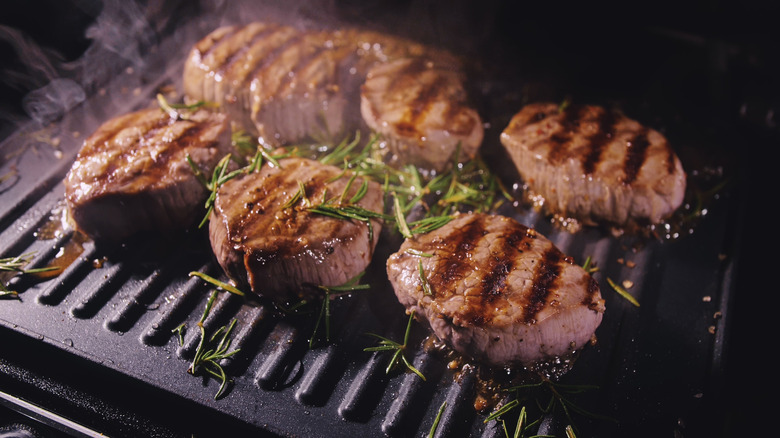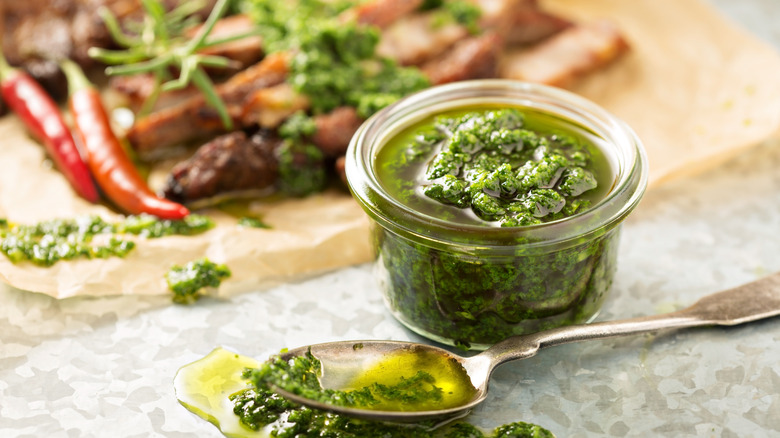What Is A Board Sauce? (And What Makes It Worth The Mess)
There are so many important factors to keep in mind when cooking steak. The cook must become a keen culinary observer, focusing on temperatures, textures, tastes, and much more to avoid a tough, dry, disappointing dinner. With meat prices rising along with escalating demand and focus turning toward quality, nontraditional, humanely and/or sustainably raised options, the consumer's never been paying more attention to (or dollars for) the ever-popular, Instagrammable muscle cuts.
So it pays to do your research and cook your best with steak. While you might already be familiar with the classic flavoring and tenderizing capacities of aging, dry rubs and marinades, the oft-lauded Maillard reaction, and tricks like oiling your steak before it even hits the cooking surface, there is always more to learn about the world of grilling meat. Chef and restaurateur Adam Perry Lang devised a simple and ingenious steak hack that every aspiring grill master needs to know.
All aboard for perfect steak
In his book "Charred & Scruffed," Lang writes (via SportingRoad), "Once I have grilled a piece of meat, I want to capture the flavors of the delicious juices that emerge on the cutting board when I slice it and then build upon them, so I make what I call a board dressing."
His recipe's been lovingly adapted by many a steak lover, usually involving extra virgin olive oil, fresh parsley, salt, and pepper. But Lang also says (via Williams Sonoma) that you can dress your cutting board with barbecue sauce or vinaigrette or substitute fat drippings for the oil (per SportingRoad). William Sonoma adds that the idea is to boost flavor while reintroducing any moisture that may have been lost while the meat rests or when it's cut up.
On The Rachael Ray Show, Lang explains that you can use sprigs of fresh rosemary, thyme, or sage (or all of the above) attached to a large utensil to baste your meat while it cooks. SportingRoad writes that the herb brush will become softer and more aromatic as time goes on, and of course, you incorporate those fresh herbs into your board sauce afterward. Lang also reports that a board dressing can ensure your grilled meat is juicy and delicious throughout (via Men's Health) and that you should flip your meat once as it rests and when you slice it and finish with additional seasoning (like herbed salt) for optimal flavor.
Making your own board sauce
If you're ready to whip up some board sauce of your own, you should hold off until you're ready to eat. AmazingRibs.com warns that the oil can pose a foodborne illness risk, even when refrigerated. Start scoping out steaks ahead of time: AmazingRibs likes flank, ribeye, skirt, strip, and others. Chef Lang's Man Steak with Thyme Zinfandel Sauce is a great way to hone your grilling techniques. Your newfound board sauce skill can also help elevate inexpensive cuts like chuck and sirloin, and all those green herbs pair well with grilled vegetable side dishes.
Williams Sonoma also suggests grilled chicken, pork chops, and pork tenderloin. Why not also experiment with thick, meaty seafood, like swordfish, salmon, tuna steaks, or scallops? SportingRoad suggests garlic, shallots, and hot peppers. At the same time, AmazingRibs.com adds that you'll sometimes see scallions, wine vinegar, citrus juice, or zest. And why stop at board sauce? You can eat that meat right off the cutting board, and it's undeniably fun in a primal kind of way. It's also practical — you'll dirty just one board instead of a bunch of plates, and silverware is totally optional. With board sauce, your next steak dinner can be more hands-on and enjoyable than ever.


